9-25 March 2016

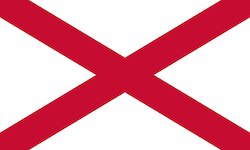
| Ireland 9-25 March 2016 |   |
We had been waiting quite a while for this. Ever since we travelled England in November, 2000, we thought a trip to Ireland was just around the corner.It was time, and what a sweet time we had.
This is no kind of tour guide or recommendation for how anyone else should plan and execute a journey there; we just always keep a daily diary of details, and that is what we share here.
But, we will say that our plans worked, and we learned even more than we could have imagined based on research, and the people and the place are more than welcoming. The infrastructure is sound, the hotel / B&B accommodations are affordable, and the prices - at this moment - are very reasonable. For example, an excellent boutique hotel or bed and breakfast was very near $100 U.S. at every place we stayed. Breakfasts were good, restaurant quality fare, and were included in all but Dublin and Galway. The feel of every stop we made was of a preserved culture, including historic structures and well-maintained, active shops and restaurants. Every server, desk clerk or guide was qualified and sincerely approachable.
We did a lot of driving, which is a big decision since you are in the wrong seat, driving in the wrong lane, and engulfed by traffic and smaller roads that have very little patience for your rookie status. We did just fine, however, missing but a couple of minor turns in two weeks. We were able to soak up the feel of the rolling, water-decorated countryside, with its cliff-lined shores and glorious, historic structures along the way.
We knew that we would be there for St. Patrick's Day. When we made the choice and bought plane tickets about eight months ahead, however, we did not take into account the fact that the 100-year anniversary, or Centenary as they say, of the Easter Rising would coincide with the dates of our trip. This time of reflection by the people, both in Northern Ireland and the Irish Republic, added significantly to the depth of our exposure to the history that still roils this land when the subject comes up, as it does, literally all the time. (England has its own opinions on the topic, with some opinions giving Great Britain a pass and others accepting their share of fault, as we learned on some BBC documentaries and some of their interviews with historians.)
The good news is that, in our interactions with the Irish people, nobody, not one, brought up the topic. Out of courtesy and an awareness that it is not our battle, we would have demurred, even if they had.
May the road rise to meet you. It certainly did so for us, physically and metaphorically for our entire, happy visit.
Wednesday-Thursday, 9-10 March
We flew to Dublin directly from Chicago in under eight hours and were in our hotel by 7:00am thanks to a friendly, early check-in. The Davenport Hotel near Merrion Square (photo on left) dates back to the nineteenth century as Merrion Hall: a former Plymouth Brethren Gospel Hall. After a fire, only the Italianate facade remains.
After a quick nap and shower, we were out for lunch at The Ginger Man for Marisa's chicken curry and Wade's fish and chips. And two pints of Guinness.
Then, climbing on the slick, hop-on-hop-off double-decker, open top bus, we joined visitors of many languages. The driver is a monologist extraordinaire, barely taking a breath between site/sight descriptions, suggestive and corny jokes, and Irish ditties - all into his microphone and while squeezing the bus through tight streets, tiny entrances and aggressive pedestrians.
As we round the impossibly small alleys near the Guinness Storehouse, he hoots about someone outside and his small dog: "Why does a dog need a feckin' jacket? He's already got a feckin' coat!" After a few more stops, we pass a bit of street construction and he has a few words about the workers: "Look at them there, all starin' down the hole, breastfeedin' their shovels." Marisa is reminded of her dad now.
A great way to start a visit. Actually.
2016 is the 100-year anniversary of the Easter Uprising that birthed the independent Ireland we know today. Our first landmark was Kilmainham (kill-MANE-um) Gaol where leaders of five different anti-English rebellions were detained from 1798 through 1916. It was the execution here of fifteen leaders (Roger Casement was executed elsewhere) in 1916 that firmly established the movement that would break centuries of English rule. This, after many more lives lost and broken ranks within the movement itself.
The prison had been built to reform the penal system and fell short in many ways during its lifetime of 128 years. As we walked around, with a docent and tour group, the grim images of a dangerous confinement are worse than reading about them can convey. The largest room (the Victorian Wing) was designed as a panopticon, allowing every one of the 96 cell doors on three levels to be watched from a single guard station. There is a lockable peep hole on each solid door and a padlock remaining on many. The ceiling of the hall lets sun in and when you look into each cell, there is an outside window.
Though these cells were intended for a single prisoner, they often housed up to five prisoners. The rough condition of the stone, metal and steel makes clear the brutality and hopelessness that was experienced by those who came here.
In the outdoor rock-breaking yard, the stone walls are 60 feet high. On each end of the yard is now a black cross, marking the sites where the 1916 rebel leaders were executed by firing squads, one (James Connolly) badly injured ahead of time was brought from the hospital and strapped to a chair for the final barrage.
The walk through this monument to aggressive incarceration and bold rebellion takes less than an hour, but makes an indelible impression.
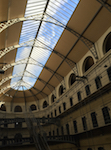
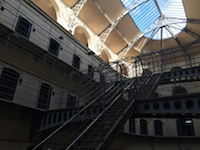
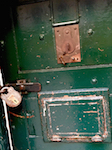
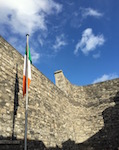
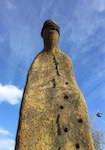
Next, we hopped on and hopped off the bus to visit the Writers Museum at Parnell Square. It is stunning and impressive to be reminded that this nation that now is home to about 6.5 million, has produced four Nobel Prizes for literature: Seamus Heaney (1995), Samuel Beckett (1969), George Bernard Shaw (1925), and W.B. Yeats (1923). The list of great writers, playwrights and poets goes on and on.
Going back to the hotel, we hopped on the bus to ride the Docklands route, getting a different view from a different driver, but still with stories, wit and song. Serious multi-taskers, these lads.
Surprisingly nice room service meal and an early bedtime completed an efficient thirty-hour day since leaving our house at 7:00am CST the day before. Hit the sack at 8:00pm, Dublin time. Ahhhh...
Friday, 11 March
Breakfast buffet - not our usual choice - was very satisfying at the hotel.
Then we walked the half mile or so to the Book of Kells exhibit at the Trinity College library. We paid for the decently expensive ticket, bought the first tour time, and then... Well, the exhibit is beautifully done and the illuminated Bible from 800 A.D. is stunning, but one only gets to see four pages in two of the four volumes. Meh...
Hopping on after sitting outside on the college campus with a cup of coffee and students walking by, we went to St. Patrick's Cathedral (now Church of Ireland, not Roman Catholic). This twelfth-century building stands on the site where St. Patrick baptized some of the pagan Irish in 450 A.D. As with so many important relics of churches that have survived to this day, from plus/minus a thousand years, the bones are impressive and the tacky mercantilism of church tourism can overwhelm the awe. It seems to need a bit of sprucing up and removal of random display elements left leaning, dangling or languishing in the halls and corners. Still, a monument to enjoy and probably most interesting to the two of us because Jonathan Swift became Dean of the cathedral after his final fight with Queen Anne.

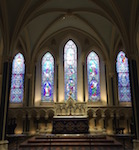
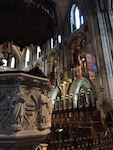
Hopped back on for a ride back to the vicinity of the hotel and strolled to a sit-down quick beer and sandwich at Kennedy's, where in the corner near our table hangs a copy of the iconic photo of JFK and RFK in silhouette, leaning forward, heads lowered, discussing the missiles in Cuba.
A late afternoon meander over to pedestrian Grafton Street and back, stopping for a book (Edwards' The Seven: The Lives and Legacies of the Founding Fathers of the Irish Republic), and some window-shopping. We began to see the weekend crowd growing for what will be St. Patrick's WEEK in Dublin. Easy dinner at the hotel.
Saturday, 12 March
Wade crossed the street from the hotel to bring back some breakfast bites and was served by a lady of Slovakian origin. She told him of her two trips to America: to Las Vegas and to Cleveland, because her boyfriend was keen to see LeBron James play.
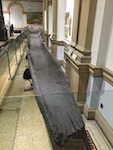
An easy walk of 15-20 minutes and we entered the National Museum of Archeology. What a gem. The relics on display date from around 2500 BC to the late 1800's. Most of the culture-revealing Viking items were unearthed in the Dublin area from the 1960's to 1990's. This collection has thus upended many myths and assumptions of the effects, locations and timelines of Irish/Viking history from about 800 - 1100 AD.
Another hop on the bus, another singing driver telling the same bits we'd heard before. The jokes about Molly Malone, the hooker, singing "Cockles and Mussels, Alive, Alive-O" sounds a bit cruel the third time around.
Lunch in the Temple Bar district at the Boxty House, a restaurant credited with diligent authenticity, gave us unique tastes. The waiter and the couple next to us engaged us in jolly conversation.
We then strolled back to the hotel by way of crowded, music-filled streets. A couple of the street bands sounded much more than buskers. And then there was an older lady with her harp. All in all, we determined that our choice to leave the capital in time for the holiday festivities was a good one.
After a rest and a small dinner at the hotel, we cabbed over to the iconic Abbey Theatre where we had purchased online tickets months ago for "The Plough and the Stars." Sean O'Casey was a provocative playwright who did not easily align with any side in the painful break from British rule. Written in 1926, the play shows the conflict and discord among even those one would assume to be ready for rebellion. There are insults and hatred toward the English and toward players of either side among volatile Irish. One character avers that the real cowards are the would-be revolutionaries who are afraid to say no to the club of revolutionaries - afraid to stand apart so as to take actual care of their family.
The production was rousing and the sets spare. The vulgarity and pointed politics are jarring when placed in the context of the 1920's when it premiered - right here at this theatre, in the middle of so much unfinished, vicious politics and cultural upheaval.
Sunday, 13 March
Last big breakfast at the Davenport, then to the airport by cab to pick up our rental car for the rest of the trip (counter-clockwise) around the island. Our female cabbie is appropriately interactive and gives a couple of good tips for adjusting to driving on the left side of the road while sitting in the right side of the car: "Wide turn to the right; tight turn to the left." It's been since the year 2000 that Wade drove across England, describing how his butt was slower than his brain to adjust to being out of place on two levels.After getting the car and a portable WiFi hotspot, we took off for Bru na Boinne, a uniquely genuine and aggressively restored piece of human history dating to as early as 3200 BC. The site is a complex of Neolithic mounds, stones and henges, but we would visit only the central mound - Newgrange. Our walking group of about fifteen adults and one child first listened to the docent's description, then went into the tiny space inside this passage tomb. We had been advised to stay out if claustrophobic, and for good reason. Shoulders turned, heads ducking and sometimes bumping, we arrived at the center, maybe forty feet in. A demonstration of the alignment of the sun at daybreak on the winter solstice makes the case that there could have been a time when there was sun and stars awareness similar to that of other ancient structures such as Stonehenge in England and the Mayan and Aztec temples of the Americas.
A little pup greeted Marisa when we arrived back at the shuttle station.

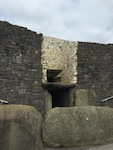
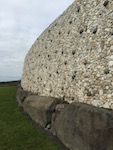
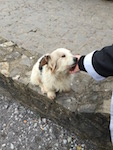
The roads' narrow, country-curving profile added to the challenge of staying safely on the left. But the rolling green landscape is an inviting and tranquil escape. About twenty minutes away, we visited Monasterboice. A Christian settlement founded in the late fifth century, the tower and ruins are a bit later and the famous high crosses are tenth century. The eighteen-foot high cross is considered the finest in all of Ireland. And we were there. Alone. In the middle of open fields.
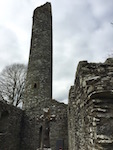
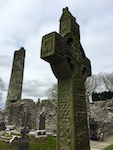
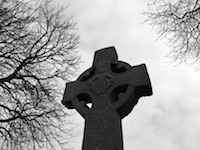
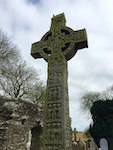
For the remainder of our ride to our next destination - Portrush on the Antrim Coast of Northern Ireland - Marisa navigated with warnings of upcoming roundabouts and route changes. There was hardly a hitch for the remaining ninety minutes to our hotel in the family and golf destination on the water.
Though the clouds were covering us, it was clear that this was a great choice for this trip. Excellent, small Hotel Adelphi welcomed us for a nap. Later we ate at Ochos Tapas across the street that offered a menu with actual international flair. Good choice.
Monday, 14 March
Copious breakfast included in our stay at the hotel gave us a sweet, mid-morning start to our day.
The sun was blazing against bright blue sky and each of the people we would encounter all day made it clear that this was the first, best day resembling spring. More than one also said that any given day goes from clouds to rain to sun and repeats year-round. We got the best, they said.
An easy eight-mile drive along the shore of cliffs and rolling tide is the rock formation / volcanic residue called the Giant's Causeway. The title comes from legends crafted to explain the 40,000 interlocking columns of six-sided lava rock that remain on the coast. There were bus tour groups around us, taking selfies and climbing over the high and low spots (several speaking in U.S. accents), but the rolling path along the glorious watery, stony edge of the ocean kept all attention.
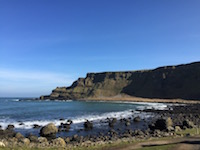
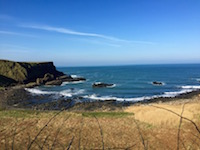
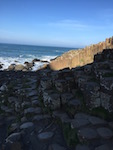
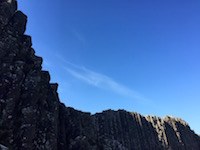
We then went about halfway back to Portrush to the ruins of the Dunluce Castle. With pieces built in the thirteenth century, the castle was eventually the home of the MacDonnells / MacDonalds through the Elizabethan Age and until a chunk of it collapsed into the sea (not unlike Monty Python and the castle that fell into the swamp?). Only the east, west and south walls still stand.
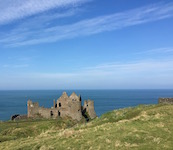
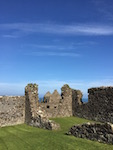
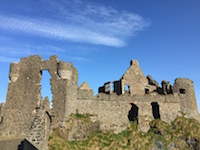
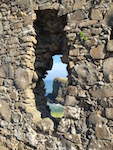
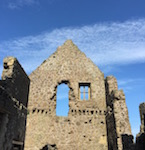
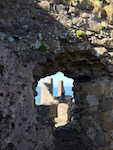
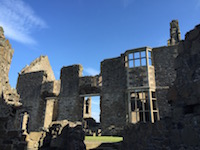
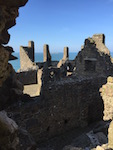
Then east again about two miles to the old Bushmills Distillery for a tour. The guide led our group of eight through the active, profitable booze factory, surprising us by showing that one of the three lines does a significant amount of bottling for Jameson, the competing Irish Republic whiskey that we would have assumed was an ancient enemy. A taste at the end of the tour put a nice ribbon on our excursion.
Back at the hotel, we had a late lunch which allowed us to have only snacks for dinner. Lying about with the telly running, we crashed by 10pm.
Tuesday, 15 March
Up for a full breakfast, then a quick walk to the train station where we rode into Belfast before noon. We chose another hop-on-hop-off. A guy in the coffee shop outside the train station suggested we ask the doorman at the Hotel Europa to help with our tickets and that was good. On a side note, that hotel has the dubious title of "most bombed hotel in the world," having suffered 28 bomb attacks during the Troubles. There is the likelihood, said our driver, that a particular hotel in Baghdad now holds the prize.We hopped on and rode for a bit over two hours, listening to the showy monologue, but learning quite a bit about the timeline and depth of those Troubles: the deadly, two-sided civilian conflict of nearly 30 years in the late twentieth century. It began in the late 1960's with a campaign to end the discrimination against the Catholic minority in Northern Ireland. Violence escalated throughout Northern Ireland, the Republic of Ireland (southern) and England. More than 3,500 people, mostly civilians, were killed in the bombings and assassinations that marked the fight between paramilitaries and state security forces. The "Good Friday" Agreement of 1998 brought an end to that round. It was surprising to see and hear that the vast majority of Belfast's interesting infrastructure dates from the Victorian Era, with a great deal of it less than 50 years old.
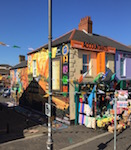
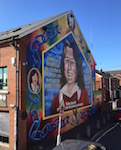
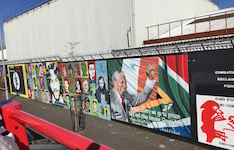
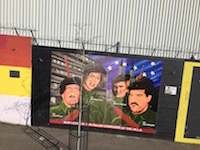
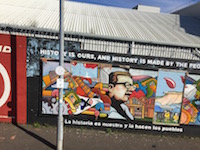
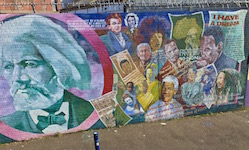
After hopping off, we made a visit to a bookstore and bought two more history books while sipping the last of several cups that day: Walsh's Bitter Freedom: Ireland in a Revolutionary World, 1918-1923 and Coogan's 1916: The Mornings After. Another easy train ride home and a stroll for dinner at 55 Degrees, a very good value right on the water, with huge glass windows. A couple sat at the next table and Marisa heard the woman softly say at one point, "They're American." The man later kicked off a conversation that went on for about 45 minutes as we finished dessert and wine.
Good laughs and friendly insight came from these two who were born in 1948. He told jokes, described parts of this northern country and trips taken to France by them with their three kids as they grew up. He made suggestions about our coming routes and informed us that the 2019 British Open golf tournament will be right there in Portrush - where, by the way, a round of golf is now about $325!
Nice finish to a smooth day.
Wednesday, 16 March
Early rising, leaving our nice hotel before the complimentary breakfast was served, we took off for a winding, curving, fog-filled journey through the countryside to our next destination. Passing, for the first time, field after field cut into plots by the old stone fences, we landed in Cong. We thought we would go to the Quiet Man museum, but it was locked tight. There were other references to the 1951 movie filmed here, including the house where the old man played by Francis Ford (Francis Ford Coppola's dad) jumped up from his death bed to watch the fight. But with Cong unavailable, we went ahead to our appointment at Ireland's School of Falconry at Ashford Castle.We arrived early, but Jamie, our red-headed American guide with a master's degree in exotic bird handling, quickly adjusted her schedule and gave us a superb experience. The Harris Hawks are situated inside large pens where each sits tethered on a perch of its own. Chico and Aztec would be our birds for our one-hour walk through the woods. They followed the guide's gentle instructions as we strolled - two birds and three humans. Jamie released them, one at a time, from each of our tethered glove perches. They would fly 20-50 yards away, usually into the trees. Then Jamie would give us a bit of raw meat to squeeze into our glove's palm. When she called to them, they returned to our wrists and when both had settled, we each opened our fists to let them eat.
We repeated this probably fifteen times as we walked. The birds' intelligence and practical friendliness was very moving to experience. After about an hour, we were back at the larger pen and they were each placed back on their perches. Unforgettable.
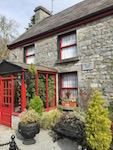
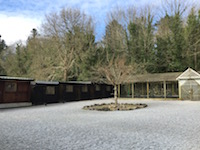
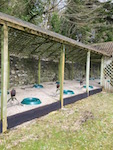
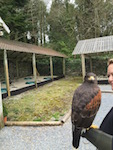
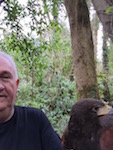
Selfies ain't easy
with a bird on your arm...From Cong to our hotel in Galway was less than an hour and we melted into our nice room near the harbor and had a nice meal in the room. A nice, long, peaceful, ten-hour journey brought us to this.
A couple of hours later we were happy to crash for a night of dreams: cliffs, fog, birds, and . . . bed.
Thursday, 17 March
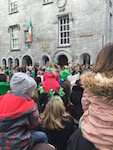
Breakfast in the hotel restaurant and a wild little event: washing and drying a load of clothes in an outdoor coin laundry kiosk at the gas station. Very new, clean, self-serve. Eight Euro for a load. Very good, considering we once (ignorantly) paid $70 to have laundry (not dry cleaning) done in an Oslo hotel.
Walking out, then up and east, we found the St. Paddy's parade and squeezed into the crowd of green to watch. The participants in the parade were much like those one sees in similar U.S. events: clubs, schools, musicians, kids on stilts, athletes, vintage cars (two 1960's Corvettes), kids on parents' shoulders, kids in strollers, some adults pushing for a little room to move down the street where, of course, the view will magically be better.
Congenial, happy crowd under a warm, blue sky. The perfect Irish parade day.
As the fire truck came last and its firemen passed the hat for who-knows-what charity, we looked around for a place to sit with a Guinness. Naturally, every joint was crowded but we landed at a pub called The King's Head. The fireplace was dated 1612. The story on the wall was that the executioner of England's Charles I in 1649 was recruited from Ireland and, after the chopping off, was given this establishment. Who can doubt that?
On our second stop, we went into Ard Bia for dessert, wine and an Irish Coffee, requested for Wade by our waitress who was astonished that we hadn't had the pleasure yet. When first seated in this small stone building on the harbor near the Spanish Arch, we were in what amounted to a hallway. A family of four next to us was being terrorized by their own three-year-old girl, who screamed with such volume and diaphragmatic power that our waitress quietly offered to move us and we accepted. We stared out the window at the calm harbor water.
Strolls by the churning river and a parallel canal; college-age kids spread out on blankets; prams, grandmas and grandpas. A big, pretty day in Galway. We returned to the hotel's fireplaces to catch up on some reading and writing, then dinner and quietly done for the day.
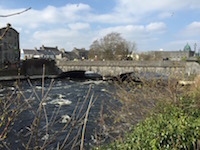
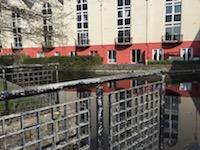
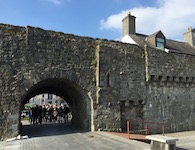
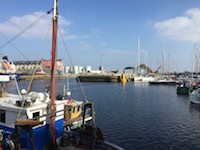
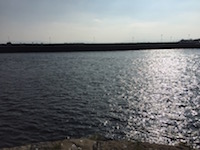
Galway 17-3-2016On Galway's streets
By door and glass,
We stride and pause 'cross seemly stone.The sun is out;
Wall vines hold back,
Their green still saved till spring be shown.Parade begins
And children jump;
Dad's shoulder perch lends perfect view.As others March
Or stroll and flip;
All ages smile and laughs ensue.St. Patrick's Day
It's green displayed;
Does not hold back what joy is due.Care's fleeting trust is shared and known.
(Wade Benson)
Friday, 18 March
Breakfast in the hotel, pay for the parking, then take off for Dingle.We were quickly out of the city of Galway, making our way through the chain of narrow, local roads and roundabouts (LOTS of roundabouts), major interstate-size highways, small towns and tour buses racing in your face in the oncoming lane.
We have learned that, as it is all across America, every driver wants to lead the way, going faster than the speed limit. On some of the narrow, hilly, bumpy, curvy roads, the speed limit is 100 km/hour. You do the math.
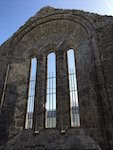
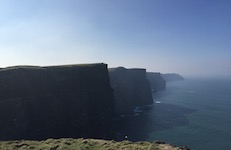
We drove through the Burrens in County Clare. It's a stark landscape of cracked limestone and scattered boulders. We didn't stop to look, but we did know that this landscape is home to both Mediterranean and arctic/alpine plants. This was also an area particularly hard hit in the potato famine in the 1840's. We stopped in the small town of Kilfenora to view the twelfth-century cathedral and the Burren Centre - a small, but beautifully done environmentally-focused museum and local cultural exhibit. And a large gift shop.
Then on to the Cliffs of Moher, perhaps better known to us Americans as the Cliffs of Insanity from The Princess Bride. As high as 800 feet above the sea. In-con-THEE-vible!
Then, as we drove on to Dingle, we hit the Connor Pass, a one-lane section of this road that requires pulling over for oncoming vehicles. So steep, so narrow, so not a casual decision. Because the drive is so intense, neither passenger nor driver can enjoy the scenery.
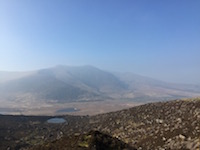
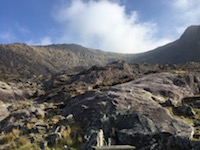
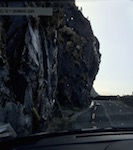
Then we glided into Dingle, to Heatons Guesthouse by the bay. Done up in a nineteenth-century style in its lobby, its welcoming is real. Easy half-mile walk to the Boatyard, a great restaurant where we were near a family with three beautifully behaved kids. Then a smooth, water-side walk back to our lovely room for reading and sleeping.
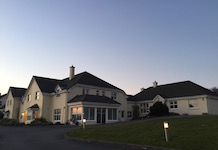
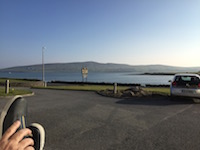
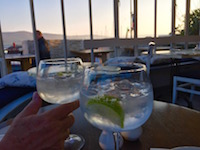
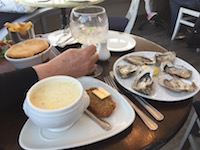
See that iron bench under
the window in the middle?That's our Happy Hour
view from that bench.
Dingle Bay and our
little rental car.And this is our second and third
happy hour at the Boatyard.
Saturday, 19 March
An amazing, world-class breakfast in this exceptional B&B: full table of starters (fruit, cereal, meats, cheeses, different fruit, breads), then you order from an extensive menu of culinary choices, mostly continental. Two kinds of Eggs Benedict for us.
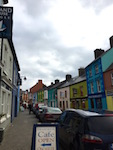
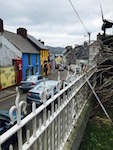
We then strolled in mid-morning to the town center, passing pubs, restaurants, gift shops, craft stores and just a couple of grocery or home supply shops. Like many of these centuries-old towns on the Irish coast, Dingle has been a center of continental - especially Spanish - trade. Dingle is still a major fishing port and those boats bob alongside the tourist ferries at the large marina on the bay.
We stopped for a coffee, then continued, slowly turning back toward the water. We walked out onto the quay and around the boats, looking back at the colorful streets.
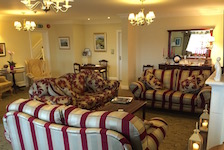
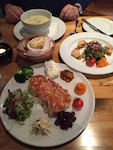
At the hotel, we had cake and coffee that is put out for guests every afternoon, (in lieu of lunch!) and Marisa found that there was a showing of a 1945 Noel Coward movie as part of a local film festival.
We went to the small Phoenix Theatre and joined maybe twenty other people. A Brief Encounter was a very intimate short story, delving into near infidelity and the retreat therefrom. Sitting there felt as if we were actually in this country, in this town, with these people.On the way back, we surprised ourselves by walking into another restaurant, Out of the Blue, and had yet another fabulous meal. (We are benefitting from the worldwide swell in the culinary arts.) Back to the Guesthouse for nothing but the vacation part of vacation.
Sunday, 20 March
Another fabulous breakfast, nice conversation with the proprietor (who has a Minnesota daughter-in-law with his son in Minneapolis). Again driving on rolling and sometimes busy roads, we passed multiple old stone structures, mostly vacant or only barely standing.
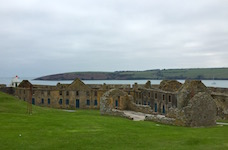
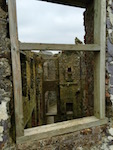
Arriving in Kinsale, our destination for the next two days, we landed immediately at the Charles Fort. Built on an even older site, this is a seventeenth-century construction that became an English stronghold on the southern coast. To this day, Kinsale is 45% Protestant. The view is tremendous and from there one can see the Old Head of Kinsale, the nearest point of land to the site of the torpedoed Lusitania.
We then drove into this old harbor town and to The Cloisters B&B. Greeted there by Orla, one of the owners, we took our key and opened the door to yet another beautiful and immaculate room. After settling for a bit, Wade strolled and scouted for our dinner location. After a nap, we ate at Cantinetta: terrific pizza (gorgonzola, pancetta and walnut) served by an Italian man who was very friendly and indicated that things are better in Ireland than in his home country.
Sated and so relaxed, we came back to the BB, read, watched documentaries about the 1916 Rising on television, and rolled over for a long night's sleep.
Monday, 21 March
Orla and Aileen, the owners, set our breakfast and it was particularly special as we were the only guests in this four-bedroom beauty. Following our individually ordered and prepared meals, they came in and we drifted into very easy, detailed conversation – the four of us. We laughed at ourselves because we covered politics and religion freely, the universally known taboo for strangers in bars and B&Bs. They had both retired from the banking business and have had this place for only five years.At Orla's insistence, we went for a guided tour with a highly-recommended team (Don & Barry) that is also recommended by Rick Steves, the travel guru. We had Barry Moloney all to ourselves (this is why we travel off-season!) for a bit more than an hour, walking and stopping and listening raptly to his well-built, deeply specific narrative about this harbor town. We had hesitated because we really don't like groups, but just the three of us made a perfect short history class.
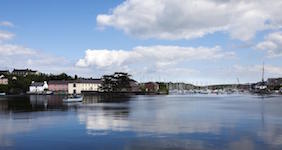
Kinsale is a fourteenth-century town with a significant military history that includes the 1601 Siege of Kinsale that ended in the defeat of both the Spanish and the powerful Irish Catholic aristocracy. After this battle, these Irish Earls fled to mainland Europe. Most of them were Ulster noblemen and their disappearance made way for the planting of English and Scottish Protestants on these old Ulster lands. And you know the rest...
We stopped for lunch at Jim Edwards (Barry's recommendation) and had seafood chowder and crab cakes, both with a unique texture and taste. Then shopping at Kinsale Crystal and a nearby glass shop. Mission accomplished. We tried to visit the Desmond Castle only a block from our B&B, but it was closed (about the only peril of traveling off-season). We spent the afternoon back at the B&B reading with a glass or two of wine.
Several restaurants were closed on Monday night and we returned to the same restaurant for dinner and had a rousing time in the crowded establishment, even though it was just dinner. We followed it with a visit to Daltons, a pub where local men spend Monday nights starting at 9:00pm playing traditional music. This night two men played the bodhran drum with a stick called a cipin or tipper; one played a banjo; another the accordion; and a fifth was there for the vocals. Older people had already packed the booths in this small room and were singing along. The space, including the bar, was no more than 800 square feet. So, yes, we stood and had a beer, soaking up as much as we could - for about four songs. Priceless, but we headed back to our room, leaving a few more square centimeters for the incoming patrons.
A very good day. Thank you, Kinsale.
Tuesday, 22 March
Sleeping a little later than usual, easing down for our breakfast at 9:00am, we were introduced to a San Diego couple and their two teenagers, the daughter being a student in Dublin. The owners were, again, very warm to all, and they followed us to the car for a good-bye. Lovely experience all around.Now, on our way to Kilkenny, we stopped at the Rock of Cashel: a walled plateau of ruined buildings and high crosses. Traditionally the home of the Kings of Munster since at least the fifth century, it was donated to the Catholic Church in the twelfth century. The oldest building - the round tower - dates back to this time. Cormac's Chapel was begun in 1127 and still stands, though surrounded by scaffolding to help dry out the stone walls and save the damp and crumbling works of wall art inside. As with many of these ancient Irish sites, the place was sacked by the English in the 1600's. Inexplicably, the Archbishop of Cashel removed the roof of the Cathedral in 1749. Wha?
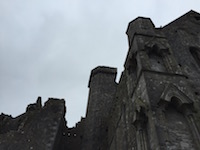
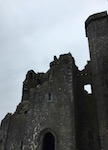

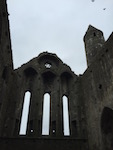
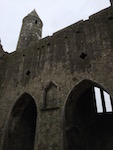
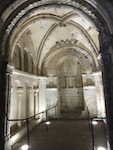
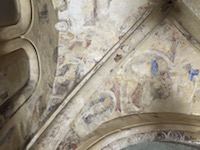
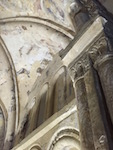
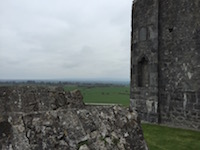
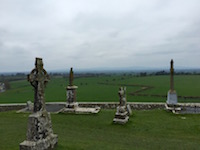
Another stop at the Jerpoint Abbey, a twelfth-century ruin noted for its stone carvings. This Cisterian abbey flourished until Henry VII's dissolution (of monasteries and himself). After the last abbot surrendered the site to Henry, the King gave it to James Butler, then earl of that dynastic family of nearby Kilkenny. (James was killed by poison five years later in London, leaving a widow in her 30's. And thus ends another tale of religion, politics and sex; not necessarily in that order.)
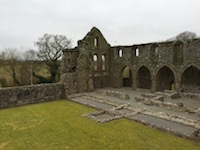
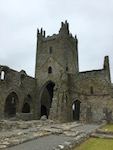
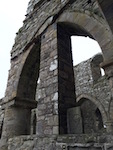
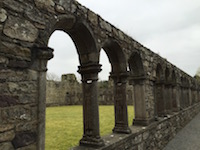
A mile or two from the Abbey ruins is the home of a glass studio and shop where we met two friendly black dogs, one of whom rolled over for Marisa, as expected. On the inside, she found some worthy trip treasures and sent one to Marisa's mom as a thanks for being "vacation hostess" for our two cats. The owner/manager lady who handled our purchase told a story of being stuck in a van a decade ago in a couple inches of snow at the Giant's Causeway. We remember that place...
Landing in Kilkenny, we went straight to Zuni, our terrific hotel, got superb snacks and wine in its restaurant, and settled in our room as the staff brought it up to us. Because this was so good, we made reservations for dinner and had a superb set of appetizers, wine and dessert in this highest-rated restaurant in Kilkenny.
Marisa read a bit in the local guidebook in our room and discovered the Watergate Theatre was fielding "Madame de Markievicz on Trial." Wade walked down for the tickets right away. With a strong cast of three women and two men, some playing multiple roles, the dialogue is based on the Countess's extensive speeches made while she was jailed after the 1916 Easter Rising. The playbill describes the goal: "to show that Madame was a normal multi-dimensional woman in contrast to the usual one-dimensional icon frequently presented."
After walking back from the play, we crashed happily in our room.
Wednesday, 23 March
Late morning and about 9:30am we walked through the restaurant on our way out to buy breakfast. NO! It's included! We forgot! So we were feeling rich with all that breakfast money saved... Time to shop.
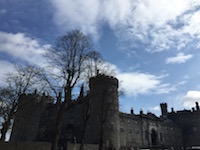
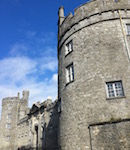
We wandered over to Kilkenny Castle, just a short walk from the hotel. A twelfth-century stronghold, it was constructed by "Strongbow," the Lord of Leinster, who was a leader in the Norman invasion of Ireland. The Castle became home to the powerful Butler dynasty, connected to the Boleyns in England. We chose not to take the tour of the restored insides, but did sit through a well-done video history in the circular Medieval Room.
This was only a small diversion on our way to the Kilkenny Design Centre across the street in what had been the coach houses and stables of the castle. Eventually, we would have three shipments to the U.S. of glass, linen, pottery, more pottery...
Back at the hotel, we sat at a table in the hotel bar with books and drinks from 3:30pm until our dinner reservation at 8:00pm. More lovely food, drinks, and off to sleep.
Thursday-Friday, 24-25 March
Another excellent breakfast by the window at the front of the hotel, then a pack-up and drive to Glendalough in the Wicklow Mountains National Park. Nestled in a glacial valley of two lakes, the sixth-century (yes, you read that right, "sixth") monastic settlement founded by St. Kevin. We have seen ruined bell towers during this trip, but this one is intact and nearly 100 feet high. It's conical roof was rebuilt of original stones in 1876, but the rest has remained as is.
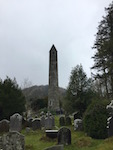
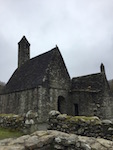
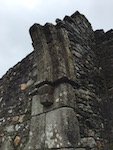
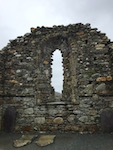
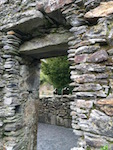

By now the small and curvy roads had become more familiar, but there were still startled gasps when we were passed by trucks and buses with only inches to spare. More scenery, and we arrived in Trim for our last night in Ireland.
Our hotel sits right across the street from the Trim Castle. We expected a basic package because we chose this hotel mostly for its reasonable distance from the Dublin airport. It was a wonderful surprise, another great room, and two busy restaurants.
No reason to completely unpack this time, so we walked across the street to the largest Anglo-Norman castle left standing in Ireland. The site for portions of Braveheart (a 1995 movie neither of us saw), the twelfth-century buildings stand at the edge of the River Boyne. The cross-shaped "keep" (tower) is unique; large portions of the curtain wall still survive; and the ruins of several buildings, including a Royal Mint, stand inside the walls. Trim marked the northern boundary of what was called The Pale: the part of Ireland surrounding Dublin that was under direct control of the English government. The Irish Parliament met here in the fifteenth century and it was granted to the Duke of Wellington in the late 1600's.
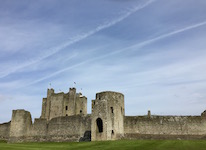
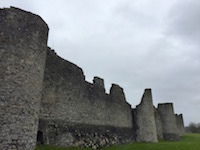
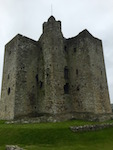

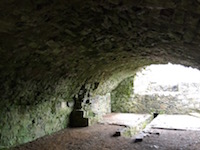
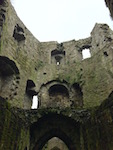
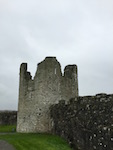
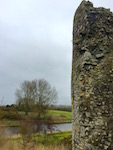
We had dinner in the restaurant, then retired for a fitful sleep in preparation for the next day. Another excellent, included breakfast before we drove to the airport for an easy drop-off of our rental car, easy three hours in the airport lounge (thank you, American Express), and an event-less flight back to Chicago. That is the goal of a final day: easy travel without "events."
So many U.S. citizens will speak of their Irish ancestry, even when they have no actual genealogical evidence to support the claim. It is an understandable wish to be connected.We are close, as nations, for many reasons, not least the fact that it is a relatively short voyage, whether by sea or air. When famine and governmental oppression by Britain were at their deadliest, neither of those curses had any power in the United States. The choice of religion, and the concrete protection afforded that choice by our Constitution, also played a large role in their near epic immigration to this country.
During our stay, several guides, or just conversing individuals, referenced the "millions" more of Irish heritage living in America than in the homeland.
So, go there. Experience how they are unique and how they are our happy cousins from a kindred country.